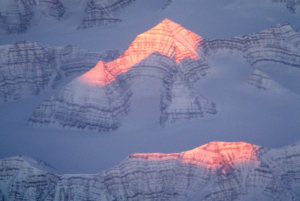SECRETS OF THE BIG EMPTY
Greenland. The name alone beckons forth a dull-white canvas so vast and subtle that detail is difficult to apprehend even at the widest embrace of the human eye. At greater distances, contradictions emerge that only add to the mystique of this empty expanse that is not green and not land. European in flavor but actually a part of the North American continent, Greenland is the third largest country in North America and the largest island on earth. Yet it has fewer people than Casper, Wyoming. It contains one-fourth of the world’s surface ice. Straighten out its jagged shoreline and you can wrap it all the way around the world at the equator.
But for all its coast and mountains, much of Greenland is already below sea level. Melt the ice and sea level would rise another 23 feet. The world’s largest island would become many smaller ones. In this and other respects the ice of this not-green not-land begins to crystallize as the real reason for the place, holding all the rest of it together and imparting a singular identity. And that is not the only thing the ice is holding together. This ice, which covers 81% of Greenland, constitutes a database that reaches back 100,000 years with surprising discrimination. Its many layers, like pages in a thick book, reveal a rollercoaster story of climate change and volcanism, sometimes with global consequences. Buried beneath all this blue-whiteness are even older databases, including the world’s oldest plant DNA on record from an ancient boreal forest that implies a much warmer chapter in earth’s history as recently as 450,000 – 900,000 years ago.
It is no surprise that science is turning an inquisitive eye to this amazing place. This Tuesday, (August 2nd) at the Teton County Library Auditorium at 6:00 pm we get to hear from Tate Meehan and Forrest McCarthy, two intrepid explorers who were part of a team that recently completed a thousand-mile, six-week science traverse of the Greenland Ice Sheet. We admire their grit and we look forward to learning more about how they accomplished this and what they discovered in the process.

